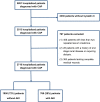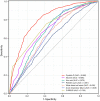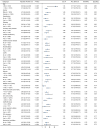Serum Cystatin C within 24 hours after admission: a potential predictor for acute kidney injury in Chinese patients with community acquired pneumonia
- PMID: 36974657
- PMCID: PMC10054292
- DOI: 10.1080/0886022X.2023.2194444
Serum Cystatin C within 24 hours after admission: a potential predictor for acute kidney injury in Chinese patients with community acquired pneumonia
Abstract
Background: Acute kidney injury (AKI) is common in patients with community-acquired pneumonia (CAP), and is associated with poor prognosis. Therefore, in this study, we evaluated whether AKI in Chinese patients with CAP could be well predicted by serum Cystatin C within 24 h after admission.
Methods: Univariate and multivariate logistic regression analyses were used to investigate independent factors of AKI in patients with CAP.
Results: Totally, 2716 patients with CAP were included in this study. 766 (28%) patients developed AKI. After multivariate logistic regression analysis, serum Cystatin C (odds ratio [OR] 4.27, 95% confidence interval [CI] 3.36-5.44; p < 0.001) was an independent factor for AKI in patients with CAP. Serum Cystatin C had an area under the receiver operating characteristic curve (AUC) of 0.81 for predicting AKI, with an optimal cutoff value of 1.37 mg/L, computing 68% sensitivity, 80% specificity. Furthermore, serum Cystatin C within 24 h after admission still had a good and stable prediction efficiency for AKI in various subgroups (age, gender, hypertension, diabetes, coronary artery disease, cardiac insufficiency, cerebrovascular disease, atrial fibrillation, chronic obstructive pulmonary disease, chronic kidney disease, and tumor, albumin, anemia, platelet count, white blood cell count, and uric acid, confusion, uremia, respiratory rate, blood pressure, and age 65 years or older [CURB-65] score, acute respiratory failure, intensive care unit admission, and mechanical ventilation) of patients with CAP (AUCs: 0.69-0.84).
Conclusion: Serum Cystatin C within 24 h after admission appears to be a good biomarker for predicting AKI in Chinese patients with CAP.
Keywords: Cystatin C; acute kidney injury; biomarker; community-acquired pneumonia.
Conflict of interest statement
No potential conflict of interest was reported by the author(s).
Figures



Similar articles
-
Serum cystatin C: A potential predictor for hospital-acquired acute kidney injury in patients with acute exacerbation of COPD.Chron Respir Dis. 2020 Jan-Dec;17:1479973120940677. doi: 10.1177/1479973120940677. Chron Respir Dis. 2020. PMID: 32924598 Free PMC article.
-
Serum Cystatin C Predicts AKI and the Prognosis of Patients in Coronary Care Unit: a Prospective, Observational Study.Kidney Blood Press Res. 2017;42(6):961-973. doi: 10.1159/000485341. Epub 2017 Nov 27. Kidney Blood Press Res. 2017. PMID: 29179178
-
Can admission serum cystatin C level be an early marker subclinical acute kidney injury in critical care patients?Scand J Clin Lab Invest. 2016;76(2):143-50. doi: 10.3109/00365513.2015.1126854. Epub 2016 Jan 15. Scand J Clin Lab Invest. 2016. PMID: 26767714
-
Serum Cystatin C as a predictor of acute kidney injury in neonates: a meta-analysis.J Pediatr (Rio J). 2022 May-Jun;98(3):230-240. doi: 10.1016/j.jped.2021.08.005. Epub 2021 Oct 16. J Pediatr (Rio J). 2022. PMID: 34662539 Free PMC article. Review.
-
The value of serum cystatin c in predicting acute kidney injury after cardiac surgery: A systematic review and meta-analysis.PLoS One. 2024 Nov 20;19(11):e0310049. doi: 10.1371/journal.pone.0310049. eCollection 2024. PLoS One. 2024. PMID: 39565808 Free PMC article.
Cited by
-
Association between initial serum cystatin C level and prognosis of aneurysmal subarachnoid hemorrhage.BMC Neurol. 2025 Apr 10;25(1):151. doi: 10.1186/s12883-025-04162-z. BMC Neurol. 2025. PMID: 40211170 Free PMC article.
References
-
- Aliberti S, Dela Cruz CS, Amati F, et al. . Community-acquired pneumonia. Lancet. 2021;398(10303):906–919. - PubMed
-
- Akram AR, Singanayagam A, Choudhury G, et al. . Incidence and prognostic implications of acute kidney injury on admission in patients with community-acquired pneumonia. Chest. 2010;138(4):825–832. - PubMed
MeSH terms
Substances
LinkOut - more resources
Full Text Sources
Medical
Miscellaneous
